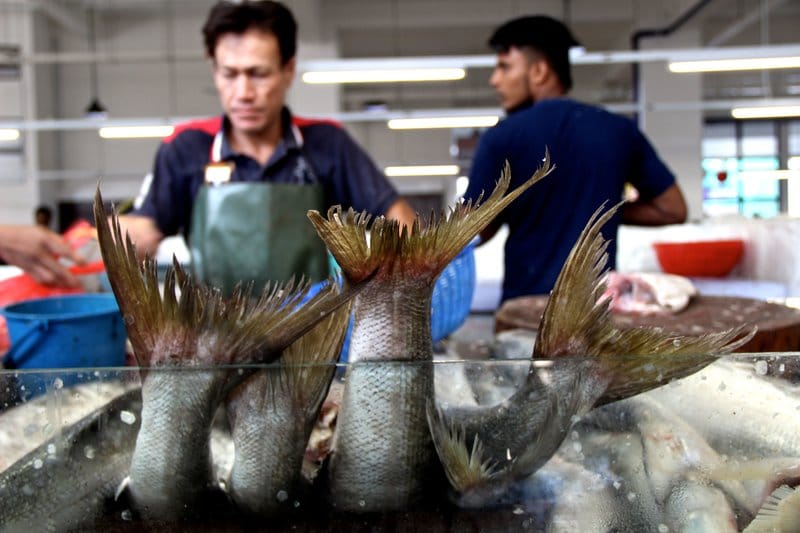
Malaysia is a stunning country, rich in history, culture and natural landscapes. Every destination is unique in its genre, and all have something to offer to the curious traveler.
But when it comes to food, nothing beats Penang, dubbed the “Culinary Capital of Malaysia.”
In fact, they have a saying on the island: “chiak si hock,” which literally means “eating brings in prosperity.” Indeed, Penangites are extremely proud of their cuisine.
As a food paradise, the island offers an endless variety of mouth-watering dishes and snacks that can satisfy the most exquisite taste buds. Penang is a melting pot of different cultures, reflected in local cuisine that incorporates Malay, Chinese, and Indian cooking.
There are endless places to eat in Penang; however, each dish has one specific stall where it is done best. For those who are indecisive, head to the open-air hawker center to find most types of local food; a great option, as most local delicacies are best sampled on the street.
It might be a novelty for some, but to Malaysians eating street food is part of their daily life.
As a food lover, heading to Penang to savor the local food was a must for me. Hopping from street stall to street stall — as well as the occasional restaurant — I gave myself time to follow locals’ advice and sample as much variety as I could fit in my stomach. The budget-friendly factor of it all didn’t hurt either.
Here is a list of local dishes that you should aim to try while visiting Penang — as well as where to find them — based on my self-guided culinary tour.
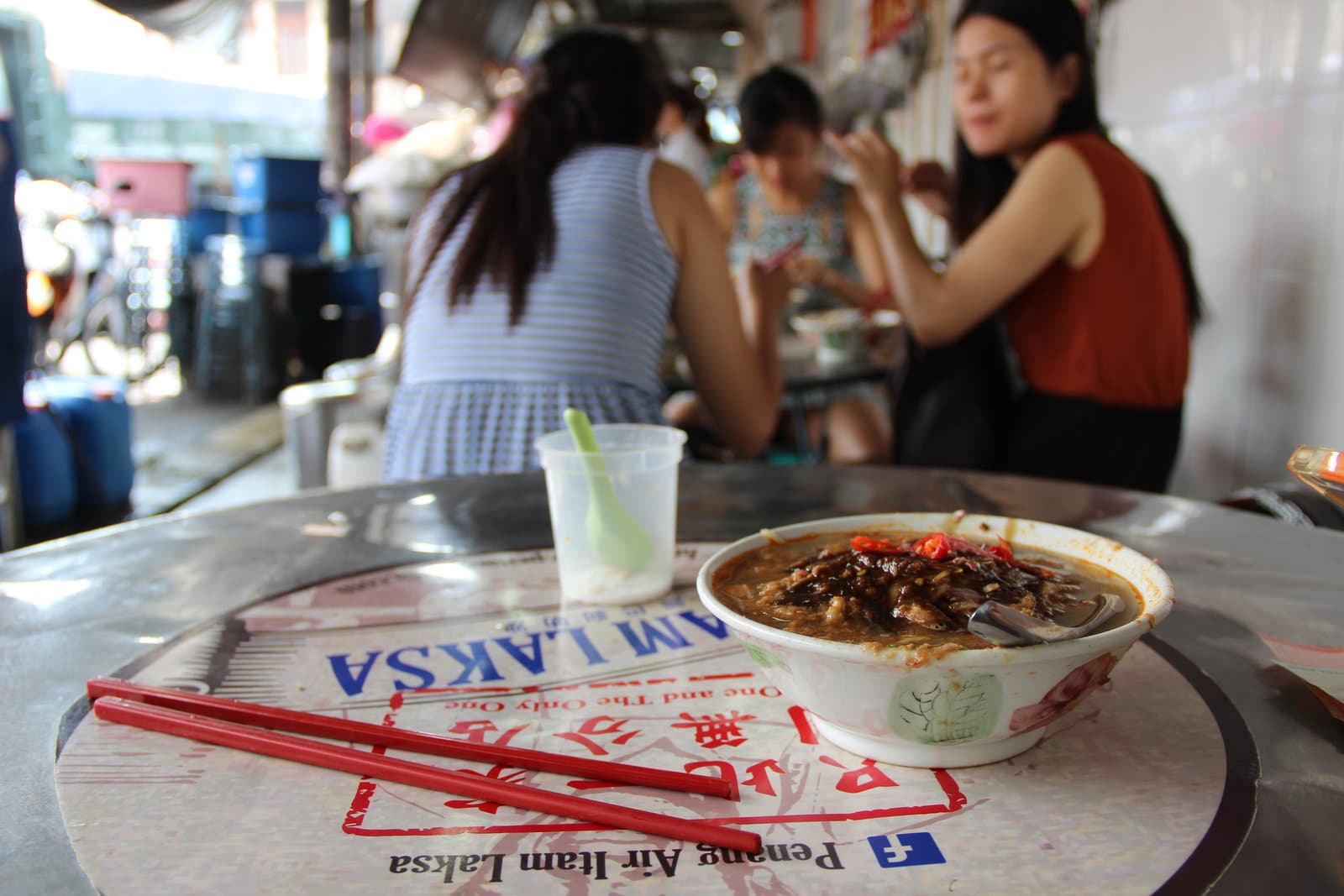
Assam Laksa
When looking for things to do in Penang, you sampling some Assam Laksa is a must.
You might have tasted Laksa in other cities, but until you have not tasted the Penang version, you have not really had Laksa.
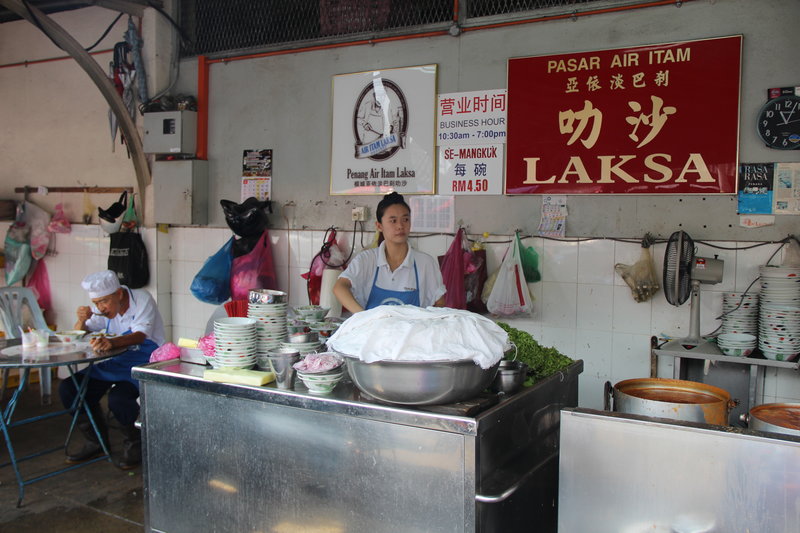
The Penang Laksa is a fish-flavored, a sour rice noodle soup generously garnished with a variety of vegetables.
Shredded mackerels are the main ingredient; however, it’s the fish paste and tamarind that give the soup its very distinct and sour taste.
To get the full aroma, add lemongrass, red chili, mint leaves, cucumber, cabbage, onions, and ginger buds.
Beware:
This soup is highly addictive!
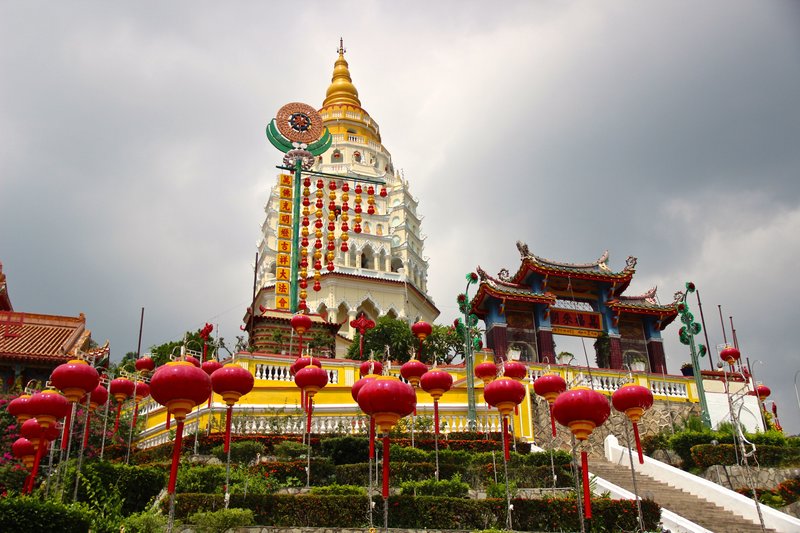
To try this dish, I headed to the most famous Laksa place on the island located close to the Kek Lok Si temple at the Ayer Itam Market.
The place is a traditional hawker stall called Penang Air Itam Laksa.
Even the famous Anthony Bourdain has been there.
In fact, their Assam Laksa tastes so good that it is not uncommon to see people heading there for a first bowl before exploring the temple, and returning for a second round after they are done with their visit.
For local Penangites, starting at lunchtime, it is always Laksa time.
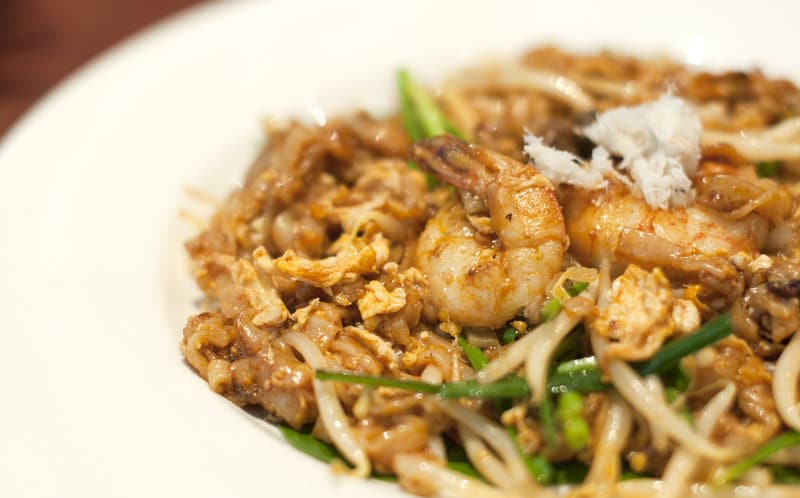
Char Kway Teow
Another local favorite is Char Kway Teow, fried flat rice noodles with prawns and bean sprouts that are mixed with black soy sauce, eggs, and chili.
It would be hard to list one place only which does it best as all Char Kway Teow sellers bring their personal touch to the recipe, but the one I preferred was on Siam Road.
As I was mesmerized by the fragrance and aroma of these tasty noodles every single time, I kept returning to this same vendor.
There is only one street store selling Char Kway Teow here, so you won’t miss it (especially with the long lines, although it’s worth the wait).
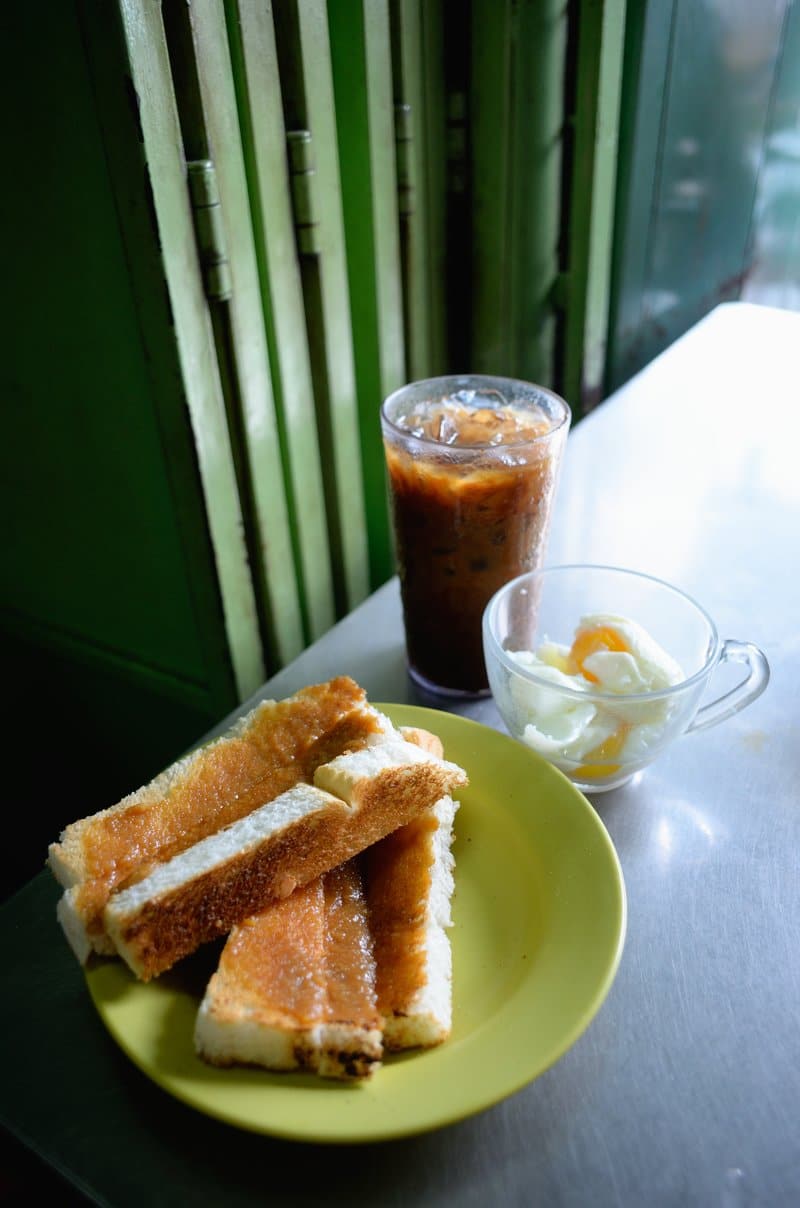
Kaya Toast With Half-Boiled Egg (And Nasi Lemak)
In Penang you’ll never need to overthink what to eat for breakfast; just head to the little Toh Soon Cafe on Campbell Street for an authentic morning experience.
Traditional and tasty, I went there quite a number of times. Together with a cup of coffee to wake me up, I always ordered their sweet kaya toast, dipping it in a half-boiled egg — a local specialty.
It’s delicious; however, if you’re still not convinced, they also serve tasty Nasi Lemak.
This is Malaysia’s most famous coconut rice, typically wrapped in a banana leaf with classic Malay ingredients such as peanuts, chili paste, and anchovies.
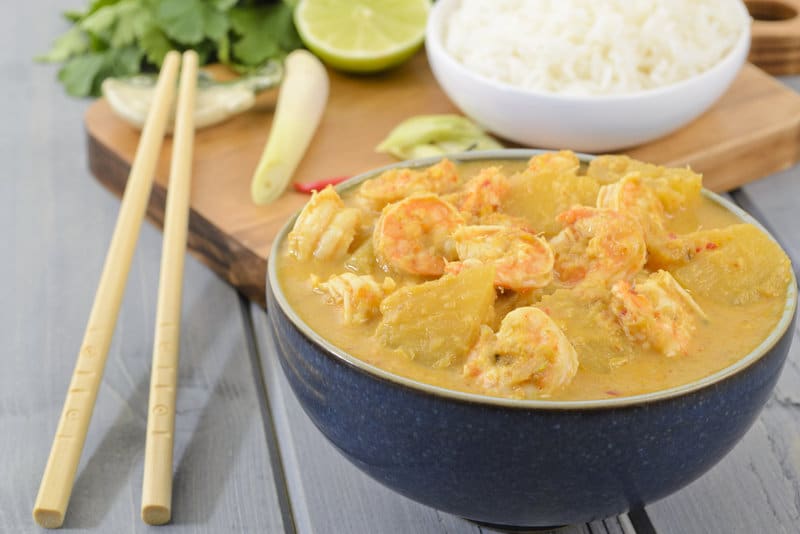
Nyonya Cuisine
Nyonya cuisine was born in the 19th century when the Chinese settled in Penang and mixed with local Malays. It consists of a combination of Malay and Chinese flavors.
What sets it apart from typical Malay and Chinese cuisines, though, is the ingredients they use. Nyonya dishes are full of fragrant herbs and spices, not to mention use pork meat.
Authentic Nyonya dishes are quite complex.
Unlike most local delicacies that can be eaten at any time of day at the island’s hawker centers, genuine Nyonya food needs to be eaten in designated Nyonya restaurants.
Preparing Nyonya food is a laborious affair as it requires hours of grinding, pounding, and marinating the ingredients.
Needless to say, I fall in love.
Nyonya cuisine is so delicate that you end up savoring every dish as slowly as you can to make the experience last longer. They have amazing curries, sweet aubergines and fragrant rice.
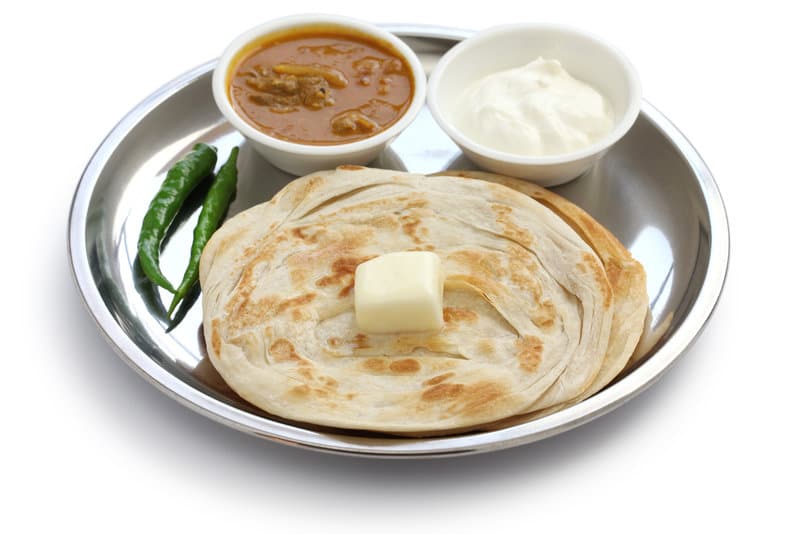
Roti Canai (And Banana Leaf)
Roti Canai is a tasty flatbread, slightly different to the original version from India, and is by far one of my favorite snacks in Penang.
It usually comes in a circle shape, sometimes accompanied by a variety of savory dips.
If you are craving something sweet simply add a bit of sugar on top — a mouth-watering treat!

For the best Roti Canai, head to Little India in beautiful Georgetown. Sri Ananda is always a good option.
In addition to making delicious Roti Canai, they’re famous for their Banana Leaf:
All-you-can-eat rice and vegetarian dips, including mouth-watering lentils, that is literally served on a banana leaf.
Their chicken skewers are also amazing.
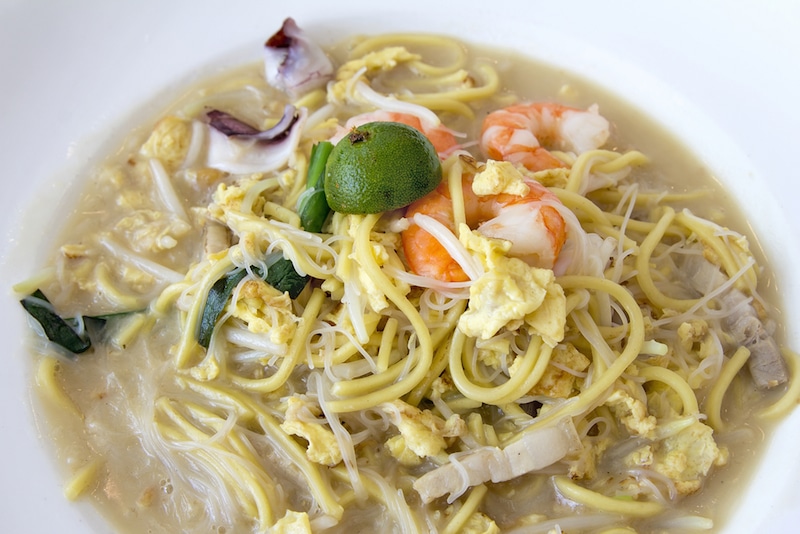
Hokkien Mee
Hokkien Mee, or Prawn Noodles, is a favorite among Penangites.
You’ll find two versions of the dish: a prawn noodle soup, as well as a dry style with dark soy sauce. Most often, locals refer to the dry version as “Hokkien Char.”
Personally, I prefer the soup. The recipe includes a variety of tasty ingredients: eggs, bean sprouts, kangkung, prawns, meat, and noodles. Historically, Hokkien Mee vendors used to walk the streets pushing their stalls, sometimes cycling them around the neighborhood while looking for customers.
Today, they’re most commonly found in hawker centers or coffee shops.
The Sungai Pinang Hawker Centre is one of my favorite food courts in Penang, as endless tasty options abound. Follow your nose to the spicy aromatic prawn noodles and you won’t be disappointed.
Enjoy!
Have you visited Penang? What was your favorite local dish?
-By Sarine Arslanian
Recommended Reads:
Singapore & Penang Street Food: Cooking and Travelling in Singapore and Malasia by Tom Vandenberghe
Penang and Its Region: The Story of an Asian Entrepot by Yeoh Seng Guan
Lonely Planet Kuala Lumpur, Melaka & Penang (Travel Guide) by Lonely Planet
Also Check Out:
Myanmar Travel: Local Finds In Urban Yangon
How Rhino Poaching Is Funding Terrorism (And How You Can Help Stop It)
Offbeat Travel: How To Get Off The Tourist Trail In Southeast Asia
Latest posts by Sarine Arslanian (see all)
- How To Find Your Purpose Through Mayan Astrology In Guatemala - Jul 5, 2017
- 6 Innovative Tools That Make Travel More Accessible - Jan 23, 2017
- Serenity & Sustainable Tourism On Kenya’s Galu Beach - Nov 21, 2016
- Mursi Women Redefine Beauty With Clay Plates - Mar 30, 2016
- How One Conscious Lifestyle Brand Is Using Fashion To Empower Women - Sep 23, 2015



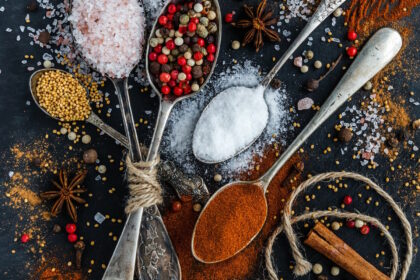


This post has made me want to book flights back to Penang and go get a HUGE dinner!
We were in Penang for a week last year and ate a lot of the dishes you mentioned above – and you are right, the laksa really is addictive!
Malaysian food was definitely one of my favourite cuisines while we were in Asia and Penang was the place where we found the best food. I can’t wait to go back someday!